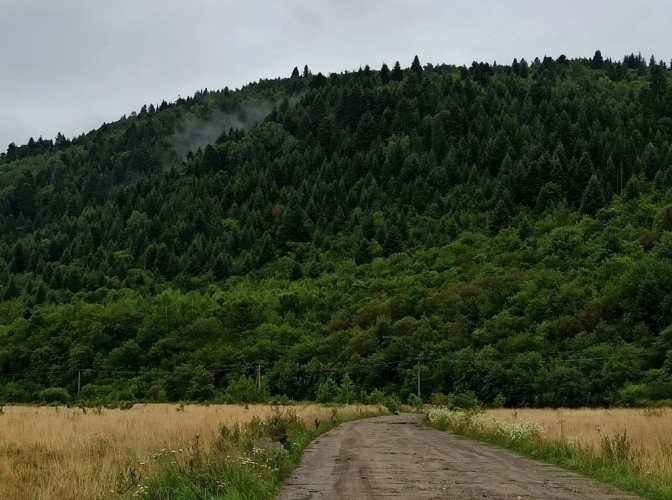
By Vitalii Holich with Kateryna Bortniak
Friday, 6 August. With my girlfriend, Katia, I was sitting in the ‘elektrychka’ – a traditional low-cost train with benches instead of seats, and also with gypsies that come round a couple of times to perform some Ukrainian folk song, accompanied with a poorly tuned guitar, and then expect the passengers to pay them for an undesired concert.
After a four-hour journey, we arrived at the gently abandoned station of Turka, made of gray concrete and filled with empty bottles from vodka and other garbage. Despite this usual appearance of the Ukrainian railway in provincial areas, this little mountain town, located in the south-western part of Ukrainian Galicia and 16km to the Polish border, preserved some unique cultural heritage, like the traditional wooden churches of Boyky [an ethnographic group of Ukrainians living in the mountains], though we didn’t have time for such a cultural program. Instead, this spot was a starting point of our one-day trip without an exact plan and route.
We intended to hitchhike through the valleys of Ukraine’s Carpathian mountains to the city of Drohobych, famous among the tourists for its well-groomed Austro-Hungarian architecture and a history of salt extraction, spend a few hours there and then hitch another ride home to Lviv that night.
At 1.05 pm, wearing my traveling hat, I walked to the train’s exit and looked at my phone while the weak network strove to send one more work message.
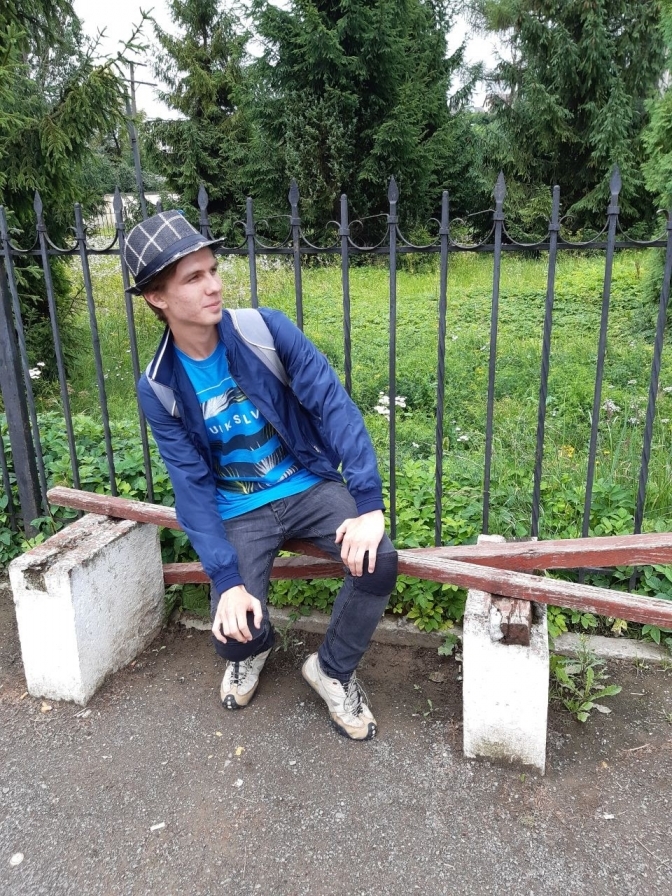
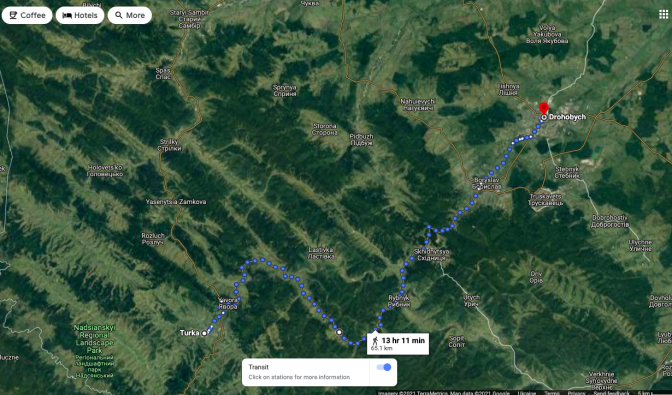
Our planned route
The towns were just control points: The main adventure waited for us during the 50 kilometers (31 miles) between. We knew nothing about this distance except how it looked on Google Maps. Nevertheless, we both thought we were ready for unexpected scenarios, even though we had no plan to prevent us from getting stuck in the middle of nowhere on a disturbingly grey-sky day.
Our first stop was just half an hour on foot from the small railway station – the Turka quarry. Previously used for stone extraction, it later became an abandoned hole of about 20 metres deep, now filled by rains and turned into a picturesque lake among cliffs and fields.
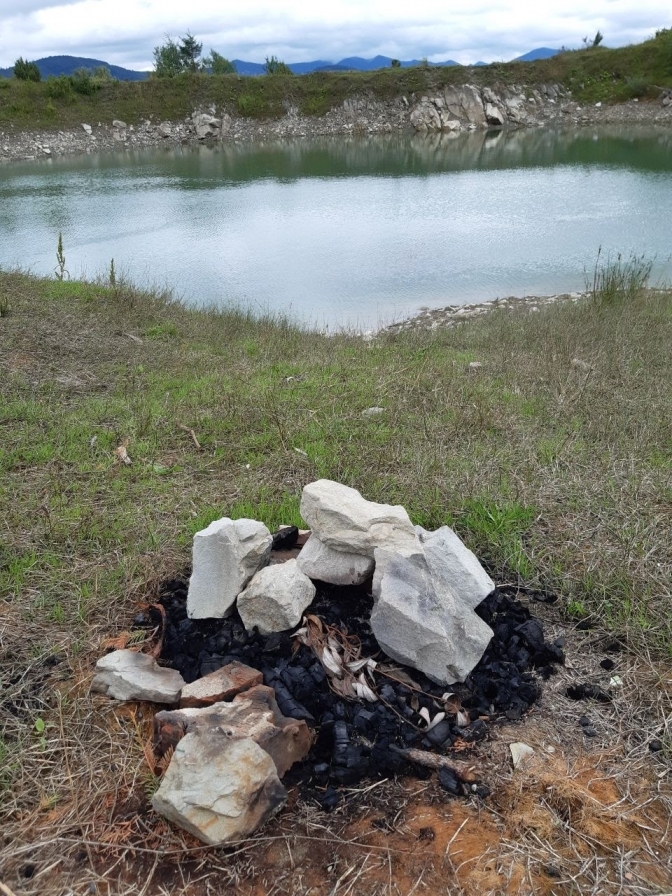
Despite the puddles all along our way and the wind’s constant efforts to tear off my hat, it was not too chilly but not warm enough, and soon we reached this charming eye of the earth, opened by years of local industry. There are days when the quarry expresses its full attractiveness under the pauseless sun rays from a white-blue sky. But during our trip, it met us with a philosophical calm that symbolised a harmony of the moment, when the water surface reflects gloomy clouds and shadows of the trees, as human consciousness reflects the reality of life.
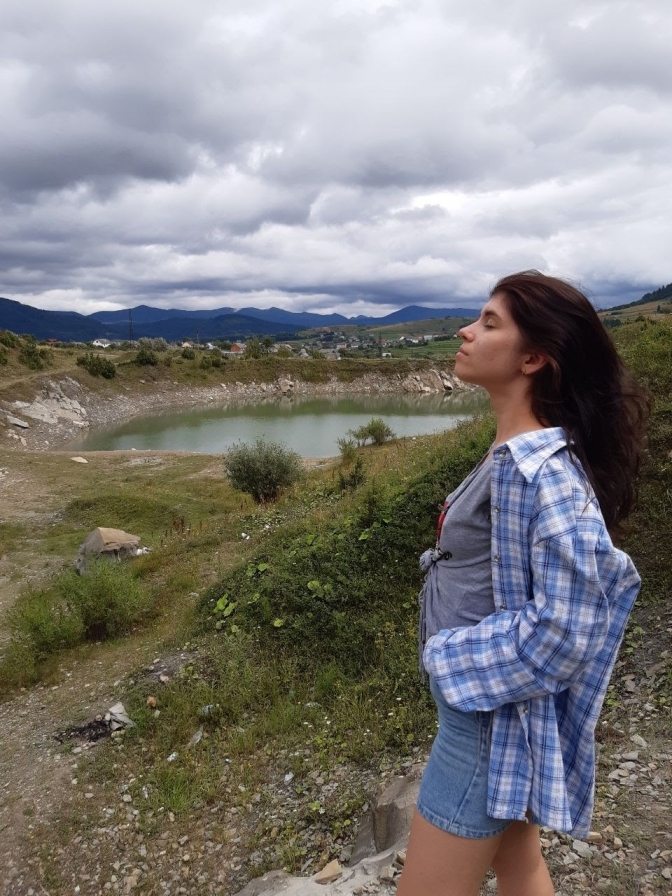
Still, the thinking-time came to an end as it was already 3pm, and we had to start hitchhiking.
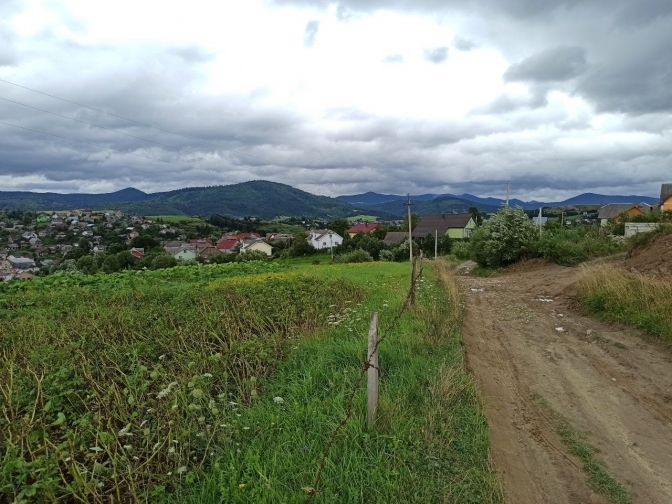
After lunching with a banana and a sweet coconut-lemon roll, we left for our next destination – the village of Yavora, few miles from Turka. On foot, the journey would take an hour and a half, ascending the town hills and going down again amid the green and stony landscapes.
But as we reached the smoothly asphalted route and moved along with our thumbs up, a black minibus stopped, and we joined a company of cheerful middle-aged men who drove with the soundtrack of folk rhythms on the radio. We told our new companions that we needed to reach the place where Yavora ends and the road forks in two directions – our route turned west, toward the tiny settlements hidden in the valleys.
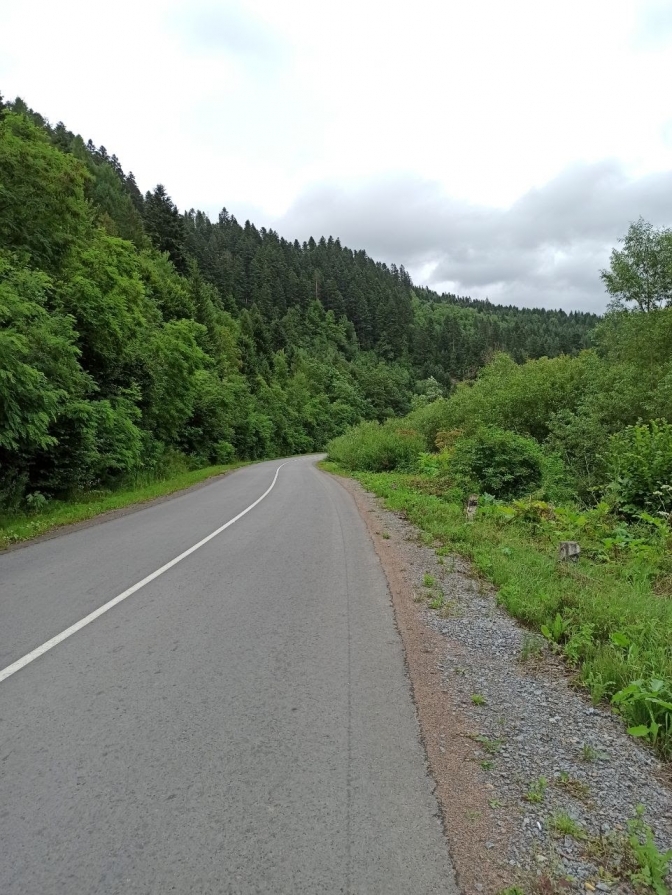
- «Drohobych? Well, I don’t think it’s possible to reach it that way,» – the driver, rather astonished, said.
The men seemed doubtful about our plan and offered us a lift in another direction to the town of Staryi Sambir, where we could easily take a bus to Lviv. We obviously thanked but refused, something made us believe that it’s possible to go this route, and the adrenalin was already reserved for the adventure. So, we bid farewell on the intersection after Yavora and stepped on the asphalt again.
Soon, a column of cyclists appeared, smiling at us with surprise and interest. They had passed us for the first time right before we had climbed into the minibus, and then, of course we had overtaken them, which gave us a temporary pride of victory. However, here they were again, regaining their position in the race.
This back-and-forth made us all laugh at the smallness of the world. However, after that, the cyclists turned somewhere, leaving us alone with the occasional drivers who stopped to give us a short lift between the neighbouring villages and ask out of curiosity where the hell we were heading.
- «Oh, you won’t get a lift all along this route. The bus has already gone, and the cars don’t drive there, because the road is destroyed,» – a young couple warned us after we entered their car.
With quite the same small-talks about our trip, we hitchhiked three more times and passed three villages, covering 15 kilometres. When we left the car in some tiny village, the rain started, and we stood hugging under the umbrella, surrounded by small rural houses spreaded among the trees and the thickets. The next car stopped without hesitation.
- «This place could become a Ukrainian Switzerland, if the state would invest in it,» – the female driver said, whose words made me much more attentive to the sights beyond the car windows as we passed near the green hills, from which dark rocks protruded. I saw a healing and economical potential in this place.
As we went on talking to the woman and her teenage son, who sat silently on another front seat, the understanding came to us that all previous warnings made sense. The road, marked with a pretty solid curve on the map, suddenly transformed into a snake-shaped route of kneaded soil wounded with millions of puddles. We were still preserved by the red body of the car and the woman who seemed to care about our further way even more than we did. She called someone, and informed us of probably the only chance to reach the nearest town.
-
«They said that workers from the resort TAOR are going to Boryslav today at 6pm, maybe you could join them,» – she said.
Although it sounded easy and promising, this mountain resort was located twelve kilometres away in a completely different direction. Now, the only option for us was to turn left and go in the direction of village Lastivka, located right on the half-way to TAOR. There, we could at least meet people, while our planned road disappeared in the dirt among almost uninhabited mountains. On the way to the village, we had no chance to catch a car on a narrow dirt road that crossed the river with a couple of concrete bridges and disappeared beneath the grassy mountains.
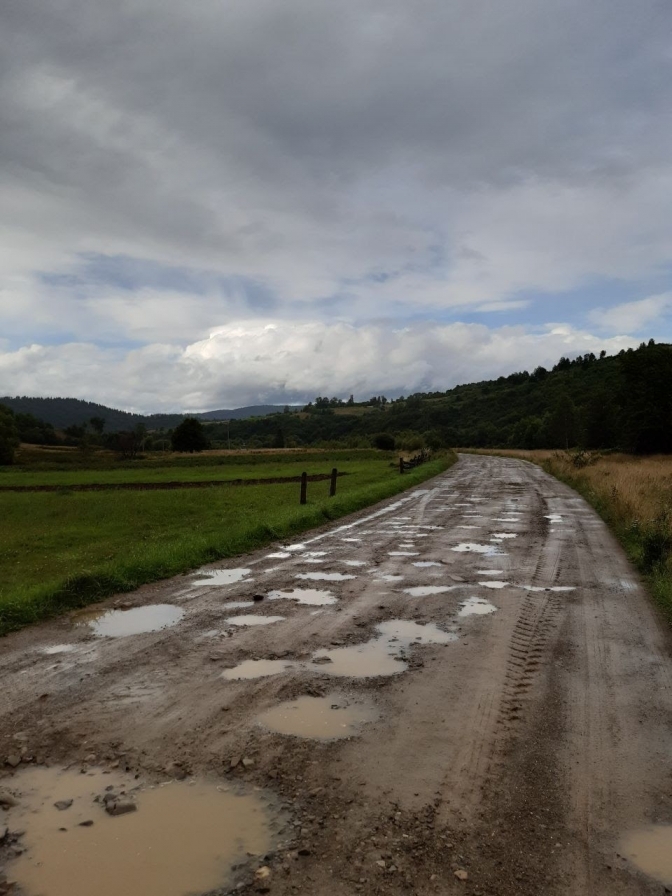
The rain became heavier for a moment, but then stopped, letting us hide our umbrellas and proceed faster. Calmness and complete absence of any buildings; the only exception was a tiny blue chapel made of wood, with its doors locked and sealed with spider web. We saw a person on a cart who directed his horse in the opposite way, and an old Soviet-made car that slowly passed us, moving somewhere nearby. This was all we saw during our six kilometres. Nature absorbed the surroundings.
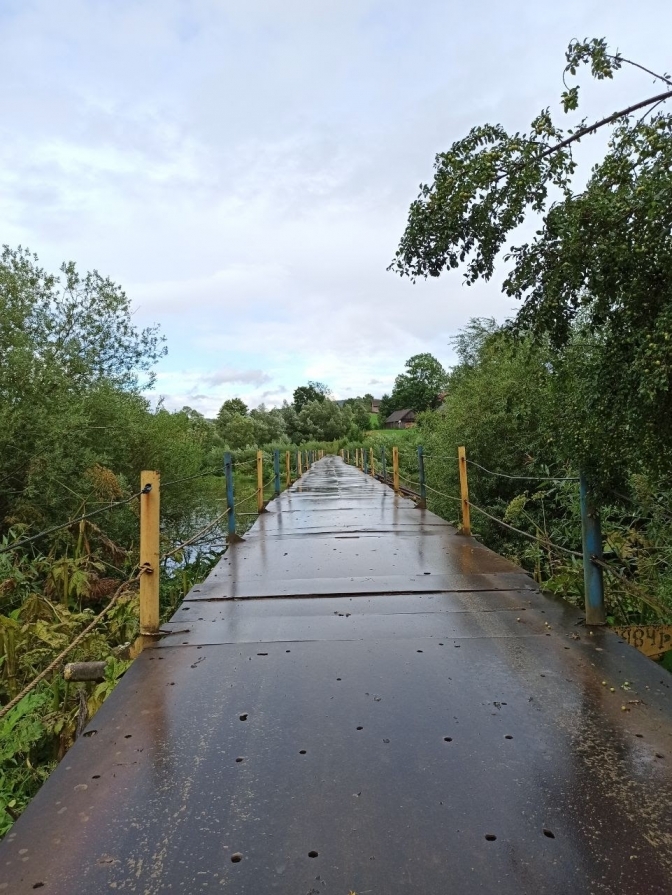
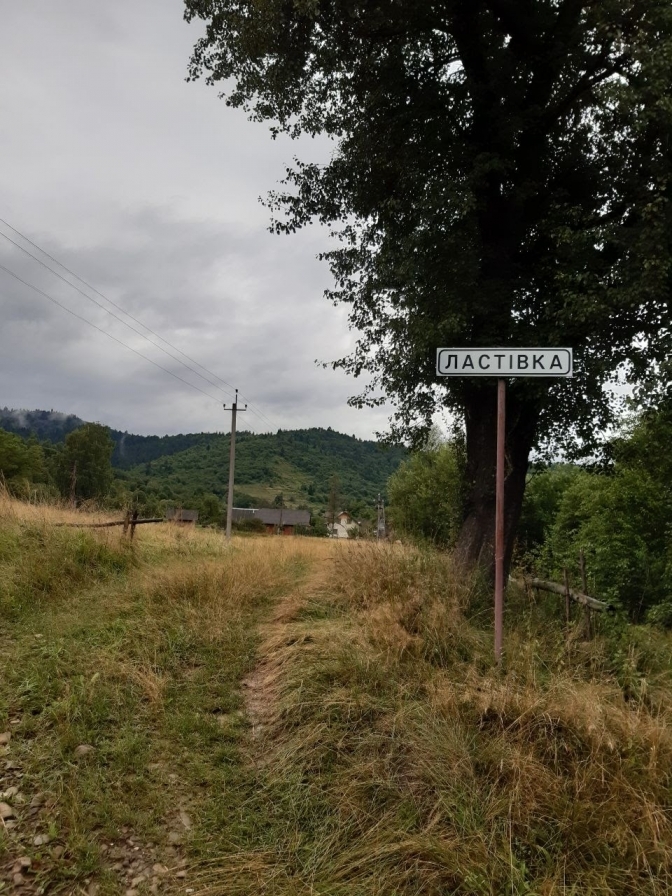
Lastivka was settled on the place where the river curved, so the road lay along its banks, and there was no possibility to shorten our way. In the beginning of the village, we saw the sign which indicated 25 kilometres to Turka – the way we had already passed, making it impossible to go back. We realised that we wouldn’t reach TAOR in time, but it still was the closest point where we could find a shelter, and Lastivka was something opposite to the previous scenery – a few buildings, and no people. We hoped to find a lift to the resort town of Skhidnytsia, located 15 km further, which could take us another 3.5 hours if we went on foot. The clock showed almost 6 pm, and we still had some daylight sifting through the pale clouds, and of course hope which we silently shared between each other.
After twenty minutes of such a walk, we saw something almost unbelievable – a car behind was slowly getting out of the village in the same direction along the path full of pits, so we stopped to wait until it caught us up. As we could expect, the driver immediately agreed to take us into his vehicle, and surprisingly, he was going to have a massage in some small spa centre in the town Novyi Kropyvnyk, located right before Skhidnytsia. This was the most inspiring part of our trip, as all the invested hope returned to us sevenfold. We joyfully conversed with this bald smiling man, despite the quite strange songs on his radio, one of which sang in Russian «I will be your maniac, I will strangle you.» Still, the reality was obvious – we had managed to hitchhike again, and were heading through the valleys to the point we had no chances to reach according to all previous warnings.
We left the car, and caught another one which took us even further–to Drohobych, a city of about 75,000, a tenth the size of Lviv.
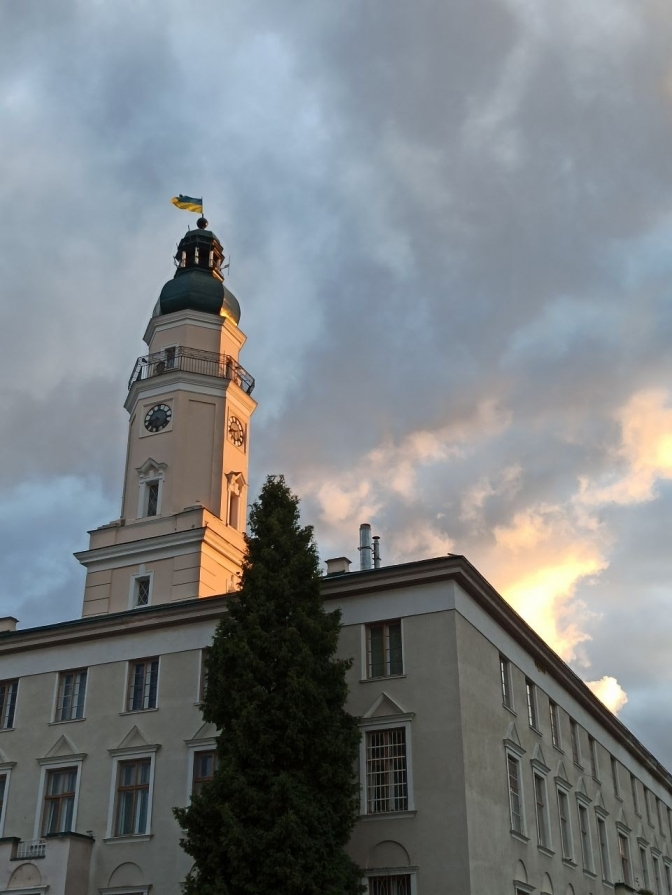
We fit into a perfect plan, as it was only 8pm when we walked around the town’s central Market Square, eating kebabs and enjoying the moment. The sun finally showed us its rays, before it disappeared on the horizon. Pavement beneath our feet restored our confidence, and the white and creamy neo-classical buildings brought peace of mind. We were so calm that we decided not to take a bus and finish the day in the same manner, hitchhiking all the way to Lviv. On the evening roads, however, this happened to be almost impossible.
-
«Still, the stars are beautiful from here,» – Katia told me peacefully as we sat in a bus stop with a broken roof without any lights, on the fenced track 30 km from Drohobych and 50 km to Lviv, at midnight.
I tried not to show any disturbance and hugged her, ready to sit unsleeping until some car would appear on this empty route in the morning.
Fortunately, a minibus appeared in about fifteen minutes and stopped after I flagged it with a flashlight, after which it took us directly to Lviv’s intersection near Victoria Gardens mall. This time, the vehicle was driven by a smiling young man, who worked as a freight taxi driver despite being a lawyer and a theologian by education. As usual, I was engaged in the conversation with him, while Katia dreamed on my shoulder despite the sounds of our voices, radio and the engine. This half an hour of driving was the biggest relief and pride for the success of this trip. Our last (tenth) car was a Bolt taxi that brought us home. The trip ended at 1 am, leaving us tired and motivated for further adventures.
By Vitalii Holich with Kateryna Bortniak
Photo by the authors
Follow Lviv Now on Facebook and Instagram. To receive our weekly email digest of stories, please follow us on Substack.
Lviv Now is an English-language website for Lviv, Ukraine’s «tech-friendly cultural hub.» It is produced by Tvoe Misto («Your City») media-hub, which also hosts regular problem-solving public forums to benefit the city and its people.












